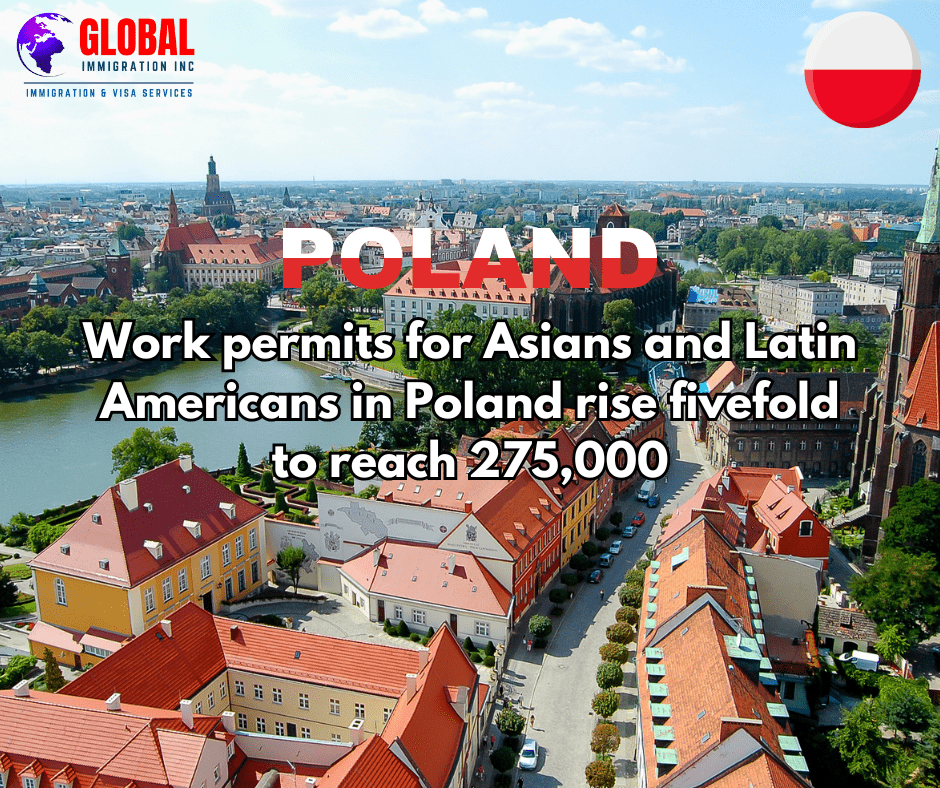Exploring the Rise of Work Permits for Asians and Latin Americans in Poland

Overview
The recent rise in work permits for Asians and Latin Americans in Poland has been significant. The number of permits issued has surged fivefold, reaching a total of 275,000. This dramatic increase reflects broader trends in globalization, economic migration, and Poland’s evolving role as a destination for workers from diverse regions.
𝗙𝗮𝗰𝘁𝗼𝗿𝘀 𝗖𝗼𝗻𝘁𝗿𝗶𝗯𝘂𝘁𝗶𝗻𝗴 𝘁𝗼 𝘁𝗵𝗲 𝗜𝗻𝗰𝗿𝗲𝗮𝘀𝗲
1. Economic Opportunities: Poland’s economy has been growing steadily, creating a demand for labor across various sectors. Industries such as manufacturing, construction, and services have expanded, attracting workers from Asia and Latin America.
2. Bilateral Agreements: Poland has strengthened its diplomatic and economic ties with several Asian and Latin American countries, facilitating easier migration and work opportunities through bilateral agreements.
3. Labor Shortages: With Poland facing labor shortages due to its aging population and the emigration of its own citizens to other EU countries, the government has been proactive in attracting foreign workers to fill these gaps.
4. Educational and Training Programs: Poland has invested in training programs and language courses to help integrate foreign workers, making it an attractive destination for job seekers from Asia and Latin America.
𝗜𝗺𝗽𝗮𝗰𝘁 𝗼𝗻 𝘁𝗵𝗲 𝗣𝗼𝗹𝗶𝘀𝗵 𝗘𝗰𝗼𝗻𝗼𝗺𝘆
1. Labor Market Dynamics: The influx of foreign workers has helped alleviate labor shortages, ensuring that industries continue to operate smoothly and efficiently. This has been particularly crucial in sectors like construction and agriculture, which have faced significant workforce challenges.
2. Economic Growth: The contribution of foreign workers has been a boon to Poland’s GDP, driving growth in various sectors. Their participation has led to increased productivity and economic output.
3. Cultural Diversity: The presence of a more diverse workforce has enriched Polish society, bringing in new cultural perspectives and fostering a more inclusive environment.
𝗖𝗵𝗮𝗹𝗹𝗲𝗻𝗴𝗲𝘀 𝗮𝗻𝗱 𝗖𝗼𝗻𝘀𝗶𝗱𝗲𝗿𝗮𝘁𝗶𝗼𝗻𝘀
1. Integration: One of the primary challenges is ensuring the smooth integration of foreign workers into Polish society. Language barriers and cultural differences can pose significant hurdles.
2. Regulatory Framework: The Polish government needs to continually update its regulatory framework to accommodate the growing number of foreign workers, ensuring their rights are protected and that they are treated fairly.
3. Public Perception: Managing public perception and preventing xenophobia is crucial. The government and other stakeholders must work to promote the benefits of a diverse workforce and address any societal tensions that may arise.
𝗙𝘂𝘁𝘂𝗿𝗲 𝗢𝘂𝘁𝗹𝗼𝗼𝗸
The trend of increasing work permits for Asians and Latin Americans in Poland is likely to continue. As Poland’s economy grows and the demand for labor remains high, the country will continue to attract workers from these regions. Future policies will need to focus on integration, fair treatment, and maximizing the economic benefits of this diverse workforce.
𝐂𝐨𝐧𝐜𝐥𝐮𝐬𝐢𝐨𝐧
The fivefold rise in work permits for Asians and Latin Americans to 275,000 is a testament to Poland’s growing role as an attractive destination for international workers. This trend brings numerous economic benefits and challenges that need to be managed carefully to ensure sustainable growth and social harmony.
